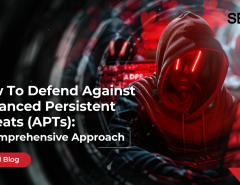The rapid increase in cyber attacks is a global reality, which doesn’t seem to be settling down anytime soon. Ponemon Institute estimates that cyber attacks on SMB’s have increased by 55 percent over the last year. With the increased digitization of businesses, more and more areas of the business are becoming susceptible to cyber attacks and defending them consistently is getting more challenging. One of the keys to securing whole IT infrastructure is by securing the network. After all, today the devices such as computers, servers, printers, etc. are connected using the network, and they play a critical role in spreading cyber infection, or data theft. It is thus crucial to secure the network to ensure the cyber safety of organization’s digital assets.
Here are some of the key elements for securing the enterprise network:
1. Perimeter security – Securing all network entry points is essential for the cyber safety of an organization. However, these entry points are not limited to just network interconnections but also extends to devices and sub-devices. With employees using their own devices to access the network, the number of such entry points, as well as the risk associated with them, is only increasing. Organizations have no choice but to ensure that their security solution addresses all endpoints. A single unsecured endpoint can spell disaster for the company.
2. Data Privacy: In case an organization does suffer a cyber attack, it is essential that the data stays protected. While access control and authorization tools usually restrict the access of data to the genuine users; the data is still exposed during transmission. Security measures such as Virtual Private Network, Tunnelling, IPSec, secure the data against eavesdropping and theft during transmission. Data encryption is a powerful tool that ensures data security for both – data in motion or at rest. It is considered as the last line of defense against data theft and thus a vital aspect of cybersecurity.
3. Security monitoring: Regular testing measures validate the effectiveness and robustness of the security systems implemented against the new attacks. Hackers are continually evolving, and new threat scenarios are being discovered every day. The existing security measures are bound to get outdated at some point in time leaving the enterprise vulnerable to attacks. Hence it is crucial to validate the security measures from time to time. Apart from identifying the security gaps, regular monitoring also uncovers if there is an ongoing attack or theft happening that may have bypassed the security.
4. Policy Management: With growing business, the network will also grow in size and complexity. It will become next to impossible to manage the network and devices on a piecemeal basis as they continue to grow. A policy-based network management tool becomes essential to efficiently keep the enterprise network up and running safely and securely. Such tools define, implement, enforce and audit the security policy across the network using an easy to manage interface and increase the usability and effectiveness of network’s security solution.
5. Identity management: Identity management is often loosely translated into access management. Though it is a crucial part of identity management, it is not all. Identity management involves accurate identification of network users, hosts, applications, services and resources. Today, it is not just the users who access the applications but also other apps and systems that access the same. This chain of access must be controlled to prevent a malicious program from getting into the critical enterprise system. The access through external channels must also be validated to originate from authentic sources only. Tools based on robust protocols such as RADIUS, TACACS+ must be used for identity management.
Network security is a dynamic activity. It requires dedicated resources and constant monitoring of internal and external threat landscape. The key to a safe IT environment is to regularly look out for possible gaps in security and keep plugging the same. An effective security solution will do these in an automated method with an easy to manage interface.
As an IT security partner for your business, Seqrite provides comprehensive endpoint security from advanced cyber threats. To know more, visit our website or




